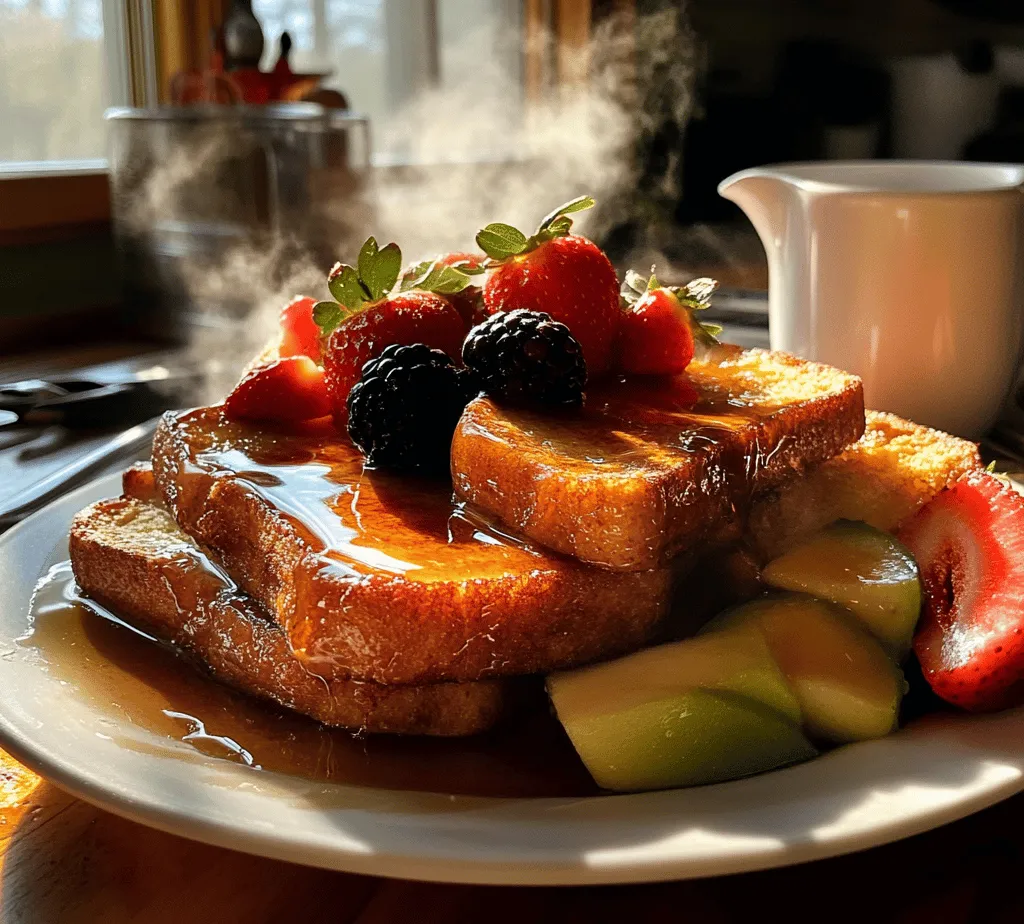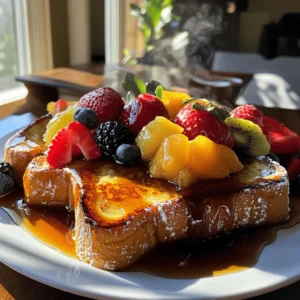Introduction
French toast is a beloved breakfast dish that has graced tables across the world for generations. Its enticing aroma and golden-brown appearance have made it a staple in many households, especially during leisurely weekend brunches. But what if you could elevate this classic dish into something truly extraordinary? Enter the Caramelized Delight French Toast—a recipe that not only pays homage to the traditional French toast but also introduces a delightful twist through the magic of caramelization.
This indulgent version of French toast combines the comforting familiarity of the original with a rich, sweet, and slightly crispy caramelized exterior. The caramelization process enhances the flavor profile, creating a deliciously complex taste sensation that is both satisfying and delightful. Whether you’re serving it at a special occasion, a festive brunch, or simply treating yourself on a Sunday morning, this Caramelized Delight French Toast is sure to impress.
What makes this recipe particularly appealing is its simplicity. With a handful of ingredients and straightforward steps, you can whip up a gourmet breakfast that feels indulgent without requiring advanced culinary skills. So, grab your apron and let’s dive into the delicious world of Caramelized Delight French Toast!
Understanding the Ingredients
The key to achieving the perfect Caramelized Delight French Toast lies in selecting the right ingredients and understanding their roles in the recipe. Each component contributes to the overall texture, flavor, and quality of the dish, making it crucial to choose wisely.
Thick Brioche or Challah Bread
For the base of this recipe, thick slices of brioche or challah bread are essential. These types of bread are rich and slightly sweet, which adds depth to the French toast. Their soft, airy texture allows them to soak up the egg mixture beautifully without falling apart, resulting in a custardy interior that contrasts perfectly with the caramelized exterior. When shopping for bread, aim for a loaf that is fresh, as day-old bread can also work well due to its ability to absorb more liquid.
Eggs
Eggs serve as the backbone of any French toast recipe. They provide structure and richness, giving the dish its characteristic custard-like texture. In this recipe, the egg mixture not only binds the ingredients together but also helps achieve a beautiful golden color when cooked. Using large eggs is recommended for the right balance of moisture and flavor.
Whole Milk
Whole milk plays a crucial role in enhancing the creaminess and moisture of the batter. It helps to create a smooth consistency that allows the bread to soak thoroughly. If you want a richer flavor, consider substituting some of the milk with heavy cream. However, whole milk is sufficient for achieving a deliciously creamy texture.
Vanilla Extract
Vanilla extract is a key ingredient that elevates the flavor of the French toast. Its warm, sweet notes complement the other ingredients, creating a harmonious blend of flavors that tantalize the taste buds. Opt for pure vanilla extract for the best results, as artificial vanilla can have a synthetic flavor that diminishes the overall taste of the dish.
Ground Cinnamon
Ground cinnamon introduces a touch of warmth and spice, enhancing the sweetness of the French toast. It’s a classic pairing with breakfast dishes and lends a cozy aroma to the cooking process. Feel free to adjust the amount based on your personal preference, but a teaspoon is usually sufficient to impart a lovely flavor without overpowering the other ingredients.
Unsalted Butter
Unsalted butter is essential for cooking the French toast and adding richness. It not only prevents the bread from sticking to the pan but also contributes to the deliciously crispy exterior. Using unsalted butter allows you to control the saltiness of the dish, ensuring a perfectly balanced flavor.
Brown Sugar
Brown sugar is the secret ingredient that creates the caramelization that gives this French toast its delightful crunch. As it melts and cooks, it transforms into a sweet, sticky coating that enhances the overall flavor. The molasses in brown sugar adds a depth of flavor that white sugar simply cannot replicate, making it the ideal choice for this recipe.
Salt
A pinch of salt may seem insignificant, but it plays a vital role in balancing the flavors of the dish. It enhances the sweetness of the brown sugar and the richness of the eggs, ensuring that every bite is perfectly seasoned.
Step-by-Step Guide to Making Caramelized Delight French Toast
Now that you understand the importance of each ingredient, it’s time to dive into the preparation of the Caramelized Delight French Toast. Follow these detailed steps to create a breakfast that is sure to impress.
Preparing the Mixture
1. Whisking the Eggs: In a large mixing bowl, crack 4 large eggs. Using a whisk or fork, beat the eggs until they are fully blended, and the yolks and whites are combined. This step is crucial as it creates the base of your custard mixture.
2. Incorporating Milk: Gradually pour in 1 cup of whole milk while continuing to whisk the eggs. Ensure that the milk is well incorporated, creating a smooth and creamy mixture. If you want a richer flavor, consider using a combination of milk and heavy cream.
3. Adding Vanilla Extract: Next, measure out 1 teaspoon of pure vanilla extract and add it to the egg and milk mixture. The vanilla will enhance the overall flavor profile and add a delightful aroma to the French toast.
4. Incorporating Ground Cinnamon: Add 1 teaspoon of ground cinnamon to the mixture. This will give your French toast a warm, inviting flavor. Whisk until the cinnamon is evenly distributed.
5. Seasoning with Salt: Finally, add a pinch of salt (about 1/4 teaspoon) to the mixture. This step is essential for balancing the sweetness and enhancing the overall flavor of your Caramelized Delight French Toast.
6. Achieving a Smooth Mixture: Continue whisking the mixture until it is completely smooth and free of lumps. A well-blended custard ensures that every slice of bread is evenly coated, resulting in a consistent texture throughout.
Soaking the Bread
Once your custard mixture is ready, it’s time to soak the bread. This step is vital, as it allows the bread to absorb the flavors of the custard and transforms it into a deliciously soft and flavorful base.
1. Preparing the Bread: Cut your brioche or challah loaf into thick slices, about 1-inch thick. The thickness is important as it allows the bread to soak up the custard without becoming overly soggy.
2. Soaking Process: One by one, immerse each slice of bread into the custard mixture, ensuring that both sides are thoroughly coated. Allow the bread to soak for about 30 seconds to 1 minute per side. The goal is to saturate the bread without it falling apart, so be gentle.
3. Draining Excess Mixture: After soaking, gently lift the bread out of the custard and allow any excess mixture to drip off. This prevents the bread from becoming overly soggy during cooking.
4. Resting the Bread: Place the soaked slices on a wire rack or a plate to rest for a few minutes. This allows the bread to absorb the custard fully and helps achieve a custardy interior when cooked.
In the next part of this article, we will continue with the cooking process, including how to achieve that perfect caramelization that makes this French toast truly delightful. Stay tuned for more tips, tricks, and the final steps to create your Caramelized Delight French Toast!

Importance of Soaking Time and Technique
When making the perfect Caramelized Delight French Toast, soaking the bread is a critical step that directly influences the texture and flavor of the final dish. Ideally, you want to allow the bread slices to soak in the custard mixture long enough to absorb the flavors without disintegrating. A soaking time of 5 to 10 minutes is generally optimal, depending on the type of bread used.
For denser breads like brioche or challah, you may find that they require a bit more time to soak up the custard. However, you should avoid soaking them for too long to prevent them from becoming too soggy. To ensure that your bread is adequately saturated, look for visual cues: the bread should look moist and slightly puffed up but still retain its structure. If you notice any liquid pooling on the surface of the bread, it’s a sign that it may have soaked for too long.
Caramelizing the Butter and Sugar
The magic of Caramelized Delight French Toast lies in the delicious caramelization process. To begin, you will need to melt butter in a skillet or frying pan over medium heat. For this recipe, approximately 4 tablespoons of unsalted butter will suffice. Once the butter has melted, add in 1/4 cup of packed brown sugar.
Stir the mixture gently, allowing the brown sugar to dissolve into the butter. The goal here is to create a syrupy base that will coat the bread while it cooks. As the mixture heats, you will notice it bubbling slightly; this is a good sign that the sugar is beginning to caramelize. Keep an eye on the color of the mixture — you want it to reach a rich, golden hue without burning. Once you achieve the perfect syrupy consistency, you’re ready to move to the next step.
Cooking the French Toast
Now that your caramel base is ready, it’s time to cook the French toast. Using the melted butter and brown sugar mixture as a base, carefully place your soaked bread slices into the skillet. Be sure to do this gently, as you want to avoid splattering the hot mixture.
Cook the bread for about 3 to 4 minutes on one side, or until it develops a beautiful golden-brown crust. To ensure even cooking, keep an eye on the color as it develops. When it’s time to flip the bread, use a spatula to gently lift the slice, checking for the caramelized color underneath. Once flipped, allow the other side to cook for an additional 3 to 4 minutes.
Signs that your French toast is perfectly caramelized include a glossy, golden-brown exterior and a subtle aroma of caramel wafting through your kitchen. Once both sides are cooked to perfection, you can remove the toast from the skillet and set it aside on a plate.
Serving Suggestions
To elevate your Caramelized Delight French Toast, consider garnishing it with fresh fruit. Slices of strawberries, blueberries, or bananas not only add vibrant color but also provide a refreshing contrast to the rich sweetness of the caramel. A sprinkle of powdered sugar can add a touch of elegance, making your dish look as delightful as it tastes.
When it comes to syrup, opt for high-quality maple syrup for drizzling over your French toast. The best types of maple syrup are those that are pure and organic, as they carry deeper flavors and fewer additives. Whether you prefer light, amber, or dark syrup, each brings its unique characteristics to the table.
For additional toppings, whipped cream is a fantastic choice, offering a light and airy texture that complements the caramelized toast beautifully. You might also consider adding chopped nuts, such as walnuts or pecans, for a delightful crunch. A dollop of Greek yogurt can provide a creamy element that balances the sweetness while adding a protein boost.
Nutritional Information
Understanding the nutritional content of your Caramelized Delight French Toast can help you enjoy this indulgent treat guilt-free. On average, one serving of this French toast contains approximately 350-400 calories. This includes carbohydrates from the bread, fats from the butter, and sugars from the brown sugar and maple syrup.
While this recipe is undoubtedly a sweet treat, it can still fit into a balanced diet. The use of eggs contributes protein, while the addition of fresh fruit adds vitamins and fiber, enhancing the nutritional profile. Moderation is key, and being mindful of portion sizes can allow you to savor this delicious breakfast without overindulgence.
Variations and Modifications
One of the best aspects of making French toast is its versatility. You can easily modify the flavor profile to suit your personal preferences. For example, consider adding a pinch of nutmeg or a splash of almond extract to the custard mixture for an extra layer of flavor. These subtle additions can elevate the dish and make it uniquely yours.
If you have dietary restrictions, there are plenty of options for modifications. For a dairy-free version, substitute the milk with almond milk, oat milk, or coconut milk. You can also use an egg substitute, such as flaxseed meal mixed with water or commercial egg replacers, to create a delicious vegan version of this recipe.
Conclusion
In summary, making Caramelized Delight French Toast is a straightforward and rewarding culinary experience. With its rich, golden-brown caramelized exterior, soft and flavorful interior, and endless topping possibilities, this dish promises to delight your taste buds and impress your guests.
Take the time to soak your bread properly, master the caramelization process, and experiment with different toppings and flavors. Whether you’re preparing it for a leisurely weekend breakfast or a special brunch gathering, this recipe is sure to become a cherished favorite. So why not give it a try? Enjoy the delightful experience of savoring your homemade Caramelized Delight French Toast today!



